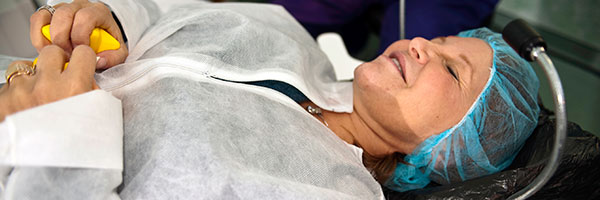LASIK

LASIK, also known as Laser-Assisted In Situ Keratomileusis or laser vision correction, is a refractive procedure that reshapes the cornea to correct nearsightedness, farsightedness and astigmatism.
LASIK is the most common type of refractive surgery. Using targeted excimer laser beam energy, the LASIK procedure reshapes corneal tissue to correct refractive errors so that light rays are focused more precisely on the retina to produce clear, sharp vision. Patients who choose to undergo LASIK achieve clear vision without the need for glasses or contact lenses, while also benefiting from minimal downtime and little to no post-operative discomfort.
Candidates Eligible for LASIK
LASIK is considered a safe procedure, yet it is not ideal for everyone. A thorough medical evaluation of the patients eyes will be performed in order to determine if the LASIK procedure is appropriate, or if the patient would benefit from another type of refractive procedure.
Candidates eligible for the LASIK procedure include patients who meet the following requirements:
- Are over 18 years old
- Not pregnant or nursing
- In general good health
- Has had stable vision for at least six months
- Has a healthy cornea thick enough for a flap
- Has refractive errors that fall within the treatable range
It is also important for patients to fully understand the details and risks of the procedure, and maintain realistic expectations as to the outcome of the procedure.
The LASIK Procedure
LASIK is performed on an outpatient basis using only numbing eye drops to reduce any potential discomfort during the procedure. The entire surgery takes less than five minutes to perform, although patients can expect to spend a few hours at the office. If requested, patients can receive an oral sedative prior to surgery to reduce any anxieties they may have.
During the LASIK procedure, the patient will lie down in a reclining chair as the doctor positions the laser precisely over the eye. A speculum will be used to keep the eye open, the eye is cleaned and numbing drops are placed. A corneal flap is created with either a microkeratome blade or a femtosecond laser. The surgeon gently lifts the surface of the cornea aside so that the excimer laser can then reshape the curvature of the cornea.
The excimer laser then delivers customized pulses of light energy based on each patient's prescription. The measurements for customization are determined prior to surgery, with the precise positioning confirmed prior to the start of the procedure. The second eye is treated right after the first, upon which patients will be given protective shields to keep the eyes safe from bright lights after LASIK.
IntraLase
The IntraLase method provides a blade-free approach to laser vision correction. IntraLase uses laser energy to create a customized flap based on the shape of the eye, providing the patient with the best possible outcome.
IntraLase offers patients many benefits over the traditional LASIK procedure, including improved accuracy and customization, a shorter recovery time and a reduced risk of flap-related complications. The IntraLase technique also allows for complete customization of the LASIK procedure to accommodate each patient's individual vision needs. All elements of surgery, including the size, location and angle of the flap, can be customized for the most precise results.
While IntraLase is considered safe for most patients, there are certain risks associated with any surgical procedure.
Recovery After the LASIK Procedure
After LASIK, patients will rest in the office for a short time before having someone else escort them home. Medication may be prescribed to relieve any discomfort, but most patients tolerate this procedure well. The doctor will likely recommend resting at home for a few hours, with most patients able to return to work and other regular activities the next day. Certain strenuous activities need to be avoided for at least a week.
The doctor will provide specific post-operative instructions to ensure proper healing and to help patients achieve the best possible vision.
Vision Results from the LASIK Procedure
Though it may take several months for full results to develop, significant visual improvement is noticeable immediately after the LASIK procedure. Most patients achieve vision that is 20/20 or better, and are able to reduce or eliminate the need for glasses or contact lenses.
While patients can achieve clear vision from LASIK, this procedure does not prevent the development of presbyopia, the age-related vision changes that occur after the age of 40. Many patients will need reading glasses for this condition, but their distance vision will remain clear.
Risks and Complications of the LASIK Procedure
Any surgical procedure carries the possibility of risks and complications. LASIK is considered safe for most patients who are considered ideal candidates. While rare, some of the complications that may occur, after the LASIK procedure, include:
- Undercorrection
- Overcorrection
- Astigmatism
- Dry eyes
- Flap complications
- Infection
- Sensitivity to light
- Halos
- Night glare
- Compromised vision
To learn more about LASIK and to find out whether or not this procedure is right for you, please contact us to schedule a consultation with one of our experienced doctors.




